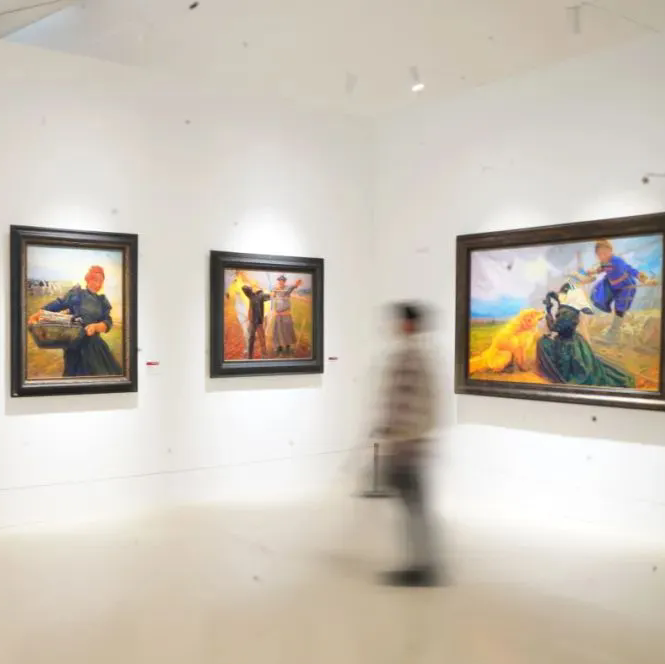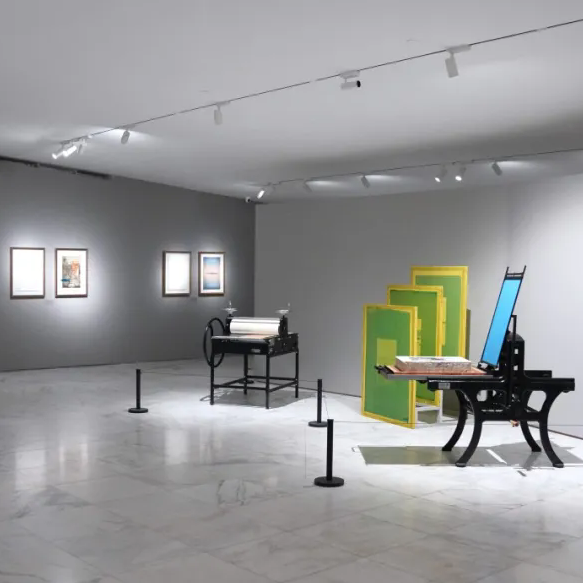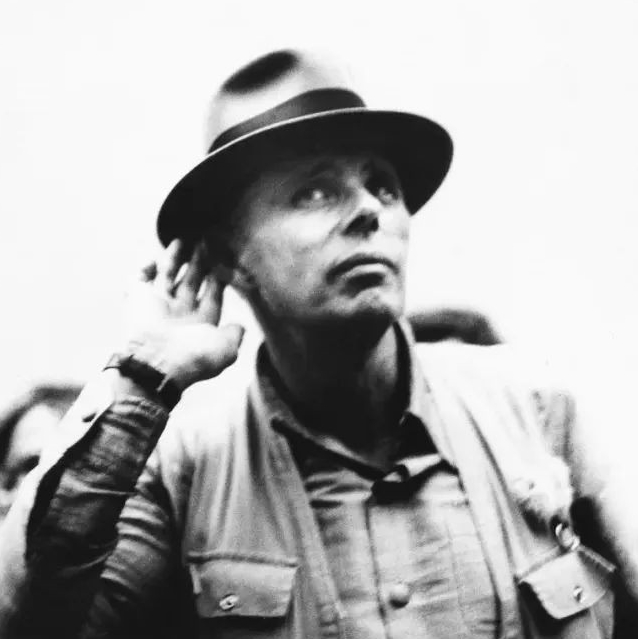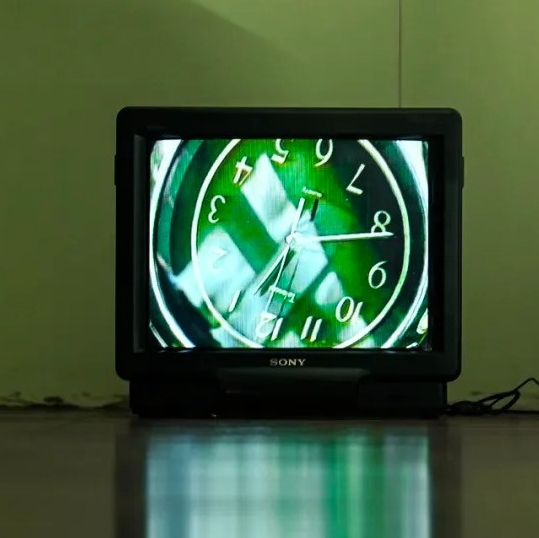Following on from Art Basel 2022 which was presented from June 15 through to June 18, the 6th Gallery Weekend Beijing kicked off on June 24, 2022. Being one of the large-scale art events, which was initially opened to the public in China in 2022, Gallery Weekend Beijing has attracted the attention from both the press and spectators. How to visit Gallery Weekend Beijing in a proper and convenient way has become the hot topic on social media such as WeChat and it has also attracted more followers than ever. How do we comprehend Gallery Weekend Beijing? And what growth and changes has it experienced over the six sessions?
 View of the Sixth Gallery Weekend Beijing in 2022, 798 Art District
View of the Sixth Gallery Weekend Beijing in 2022, 798 Art District
I.
In 2017, Beijing Gallery Weekend debuted in 798 Art District with an “experimental” attitude. From its founding, one of its founders, the German artist and writer Thomas Eller, was quite confident about it: “Beijing has everything—a lot of very good artists, very good galleries, and some good museums! What it doesn’t have is a reason to go there. ”[1] Therefore, following the model of Berlin Gallery Weekend, Thomas Eller and several gallery owners from Platform China, Galleria Continua, Magician Space, Gallery Yang and so on, co-organized to present small but exquisite exhibitions while concentrating and facilitating the viewing of the exhibitions by connecting the 798 Art District and Caochangdi. It was composed of solo and group exhibitions organized by 18 galleries featuring 67 artists/groups, and it was a great success.

Thomas Eller, German artist and Writer, Founder of Beijing Gallery Weekend
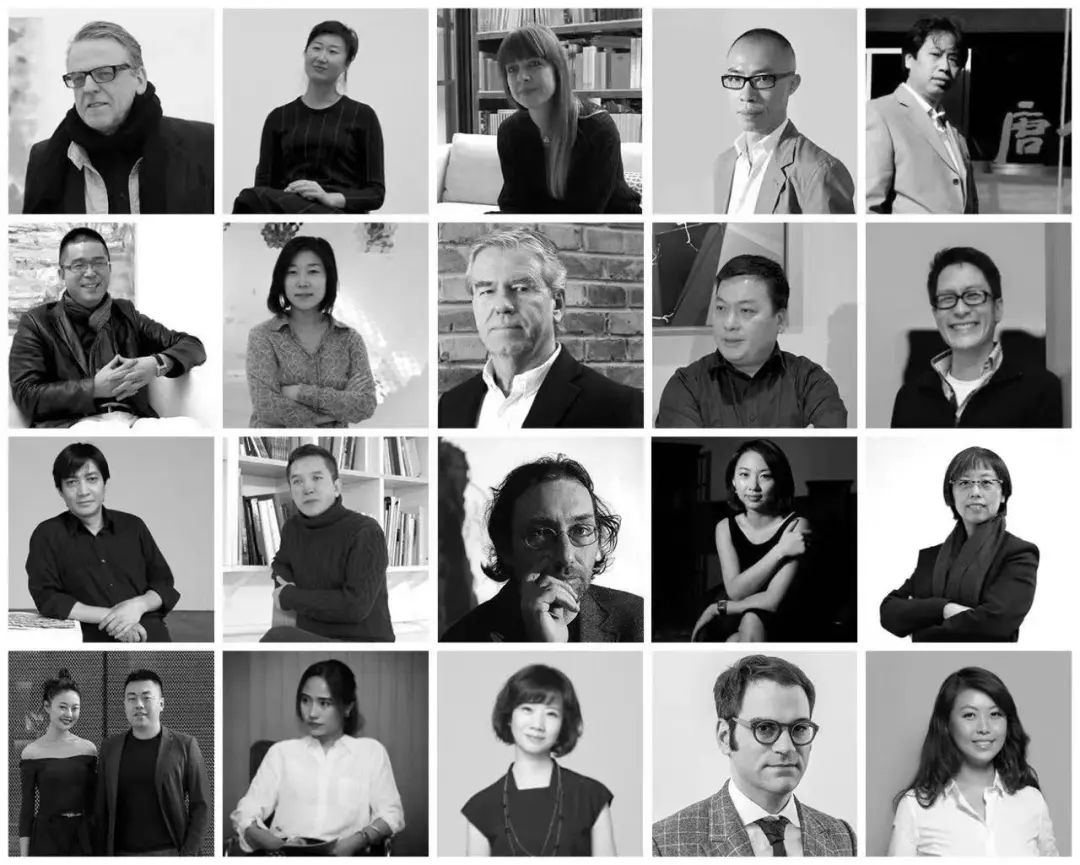

Members of Beijing Gallery Weekend (March 17-19, 2017), Courtesy GWBJ WeChat Account: gwbjofficial
While people gradually feel tired of art fairs, the launch of Gallery Weekend was undoubtedly eye-catching. How does it work? What’s the highlights? It was organized by galleries together to showcase their representative artists and works at the same time. It was first initiated in Berlin by several art dealers. Being different from traditional art fairs, it emphasizes the connection between galleries and the artists they represent, inviting the audience to visit the galleries to appreciate artworks, and literally become an art production itself: the collection, display and sales at the galleries. It makes up for the shortcoming of the instantaneous displays at the art fairs, that is, the audience may not understand the hidden meaning behind the artwork for a while. Instead, Gallery Weekend Beijing takes the gallery space as the main display container, showcases works of artists under the title with a theme, or carefully displays the creation on a certain theme or at a certain stage of individual artists. It not only provides collectors with an environment to return to the gallery space to select works, but it also enables the public to have more space for feeling and thinking.
Gallery Weekend Beijing has adopted this model and set an exhibition-related award, that is the “Best Exhibition Award”. Thomas Eller believed that in the large international art environment at that time, art creation and art markets were in a state of disconnection [2]. But the expectations from artists for the exhibitions when they created them and the information that collectors and the public get from the exhibitions, all suggest the importance of galleries and exhibitions. In addition, the opening of Gallery Weekend Beijing is usually set before or after the opening of Art Basel Hong Kong, hoping to provide collectors and art practitioners with a Beijing-Hong Kong exhibition route, and also hoping to use the luxury carriage of Art Basel to drive Gallery Weekend Beijing, and further promote the development of contemporary art in Beijing and China.

View of the First Beijing Gallery Weekend in 2017, 798 Art District


Jury Members of Beijing Gallery Weekend 2017 were discussing “Best Exhibition Award”, Courtesy GWBJ WeChat Account: gwbjofficial
Ten years ago, an event also called “Gallery Weekend Beijing” kicked off in Beijing, with the theme of “Approaching Art and Entering Galleries”, advocating people to visit galleries in their spare time and to cultivate public artistic literacy, which was also aimed at opening a new way of life and leisure. [3] Regrettably, it was held once and there was no follow-up. The reason is not difficult to understand, there is a natural gap between art and the public, and the demand can only be satisfied after the material and spiritual conditions are enriched. Although the “Beijing Gallery Weekend” initiated by Thomas Eller was not the first one, most of the team members were experts who have been devoted to art circles for many years. Starting from their actual demands, they took into account Beijing's art ecology, international art atmosphere, and groups of audiences, thus brought a sincere art event to the Beijing art world.
Meanwhile, there are also problems. The event did not make sense if the audience did not buy into it. Before Gallery Weekend Beijing, some galleries in 798 Art District spontaneously organized to open exhibitions at the same time, trying to gain a win-win situation in terms of audience numbers. From the perspective of the First Beijing Gallery Weekend, in the setting of the three programme schedules for collectors, gallery-public, and art museums, the intention was very obvious that they tried to maintain potential collectors and art professionals who usually visit Art Basel. But if only given three days to browse the group or solo exhibitions featuring 67 artists in 18 galleries, it was extremely exhausting. How can visitors be guided to separate their tours? It was far from an economic clustering effect with the First Beijing Gallery Weekend.


The Awarding Ceremony of “Best Exhibition Award” at the Second Gallery Weekend Beijing in 2018.
II.
As a new phenomenon, the audience has an observing attitude towards the appearance of Gallery Weekend Beijing and its development. Right after the first session, Thomas Eller, the CEO of Beijing Gallery Weekend announced his resignation. And it seemed that before the audience can react, the team quickly adjusted from the changes. In 2018, the Second Gallery Weekend Beijing was led by Wang Yifei, the head of Linda Gallery Beijing from Jakarta, Indonesia, and the succeeding Director of Gallery Weekend Beijing, with 18 domestic and foreign galleries and 4 non-profit institutions, the event was extended to 8 days, from the week before Art Basel to the day before its end. In addition to the newly added outdoor public projects, the “Best Exhibition Award” was retained, and VIP day forums and public day activities were also arranged. An eight-day span, was arranged as far as possible to meet the needs of collectors and the public with different schedules. According to media reports, it successfully invited about 400 domestic and foreign art collectors, art professionals, top artists and museum directors to attend. The newly added VIP forum in addition to the exhibition, the viewing experience of the public on the day, the live broadcast, and the dialogue with the artist studios have taken into account the academic nature of the Gallery Weekend Beijing and the participation of the public.


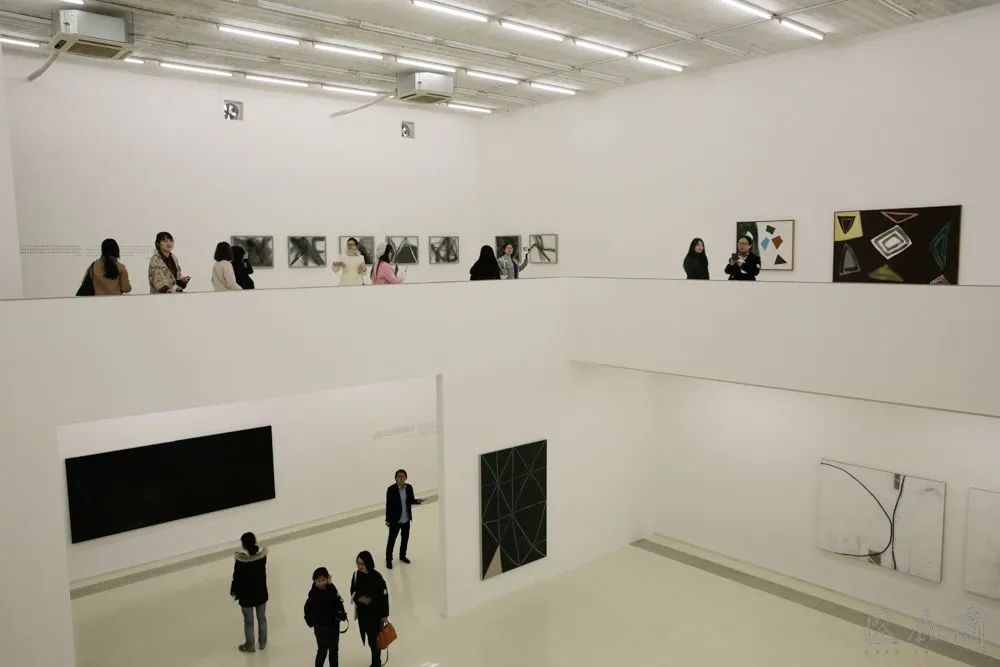
View of the Second Gallery Weekend Beijing in 2018, Image Courtesy of CAFA ART INFO
More positive signals from the Second Gallery Weekend Beijing can also be found, and some professionals have found confidence. Following that, the Third Gallery Weekend Beijing first of all included Tianzhu Town in Shunyi District and Huajiadi in Wangjing. Although the Fourth Gallery Weekend Beijing was delayed due to the pandemic, the team responded quickly and gained a firm foothold from the opportunities and challenges. The launch of its digital platform pushed the Gallery Weekend Beijing to a vast world on the Internet. The Fifth Gallery Weekend Beijing featured 37 galleries, nonprofit organizations and independent art institutions, preserving the shared experience on digital platforms. 34 galleries also participated in the Sixth Gallery Weekend Beijing in 2022, and because of the cooperation with Douyin and Aibee, a new technological upgrade has been achieved, and the enthusiasm of the audience has also been exalted due to the “closure” caused by the pandemic in the first half of 2022.

View of the Third Gallery Weekend Beijing in 2019, Courtesy GWBJ WeChat Account: gwbjofficial


View of the Fifth Gallery Weekend Beijing in 2021, Courtesy GWBJ WeChat Account: gwbjofficial
The Sixth Gallery Weekend Beijing in 2022 joined hands with Aibee, and co-launched the VR exhibition hall reproduced art scenes on mobile phones, allowing audiences to roam exhibitions without leaving home , the AR navigation covering the 798 Art District can automatically plan the optimal route for tourists to find their way / Courtesy GWBJ WeChat Account
Secondly, the program of the Gallery Weekend Beijing also tends to be diversified. In addition to the Main Sector, starting from the third edition, Gallery Weekend Beijing has planned three new special sectors, Visiting Sector, the Up&Coming Sector, and the Public Sector. The Up&Coming Sector is set up for young artists, hoping to provide guidance and help during the critical period of their career development. The Public Sector includes the public projects proposed by the second Gallery Weekend, hoping to connect with the public through public art and explore the possibility of connecting contemporary art with the public. The Visiting Sector invites qualified galleries at home and abroad to communicate and dialogue during the Gallery Weekend Beijing, expanding cultural and artistic exchanges between different regions. In addition, the Gallery Weekend Beijing also arranges special exhibitions by partners, themed forums, guided tours, studio visits, collection visits, VIP nights, public day dialogues, forums, performances, art tours and other diversified projects on the VIP day.
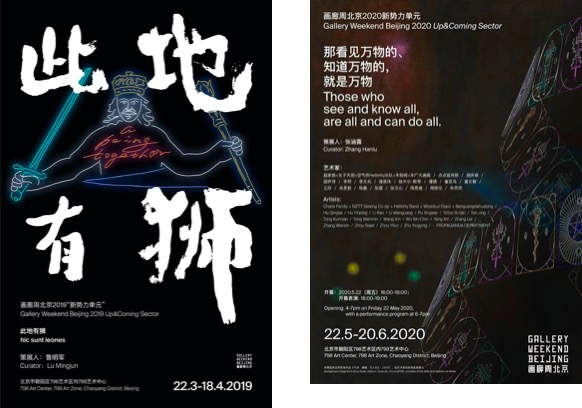
Poster of the Up&Coming Sector at Gallery Weekend Beijing

Poster of Public Sector at Gallery Weekend Beijing, Courtesy GWBJ WeChat Account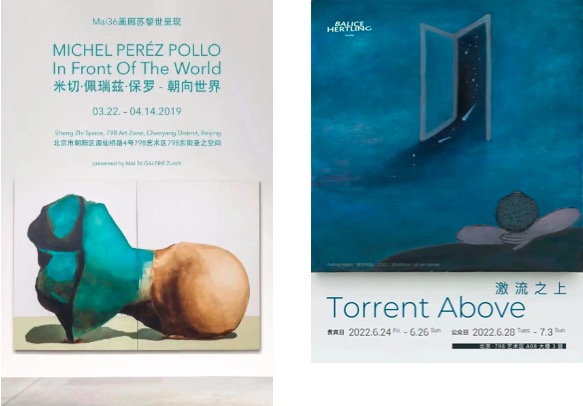
Poster of Visiting Sector at Gallery Weekend Beijing, Courtesy GWBJ WeChat Account
In such a context, whether they are collectors or art professionals who want to visit exhibitions in depth, or visit artists' studios and the collections of galleries, whether the public enters the exhibition gallery of the Main Sector to visit the exhibition, they participate in a thematic forum or lecture, or stop for the public works on display. When they come to Gallery Weekend Beijing, they can watch and experience exhibitions according to their own interests. Since the Fourth Gallery Weekend Beijing, the duration has been extended to ten days, during this period the audience has two weekends to watch the exhibitions. It can be said that the rich projects and more humanized arrangements of Gallery Weekend Beijing have made a good stratification and diversion for the participants.


Public Day Activities at Gallery Weekend Beijing, Courtesy GWBJ WeChat Account
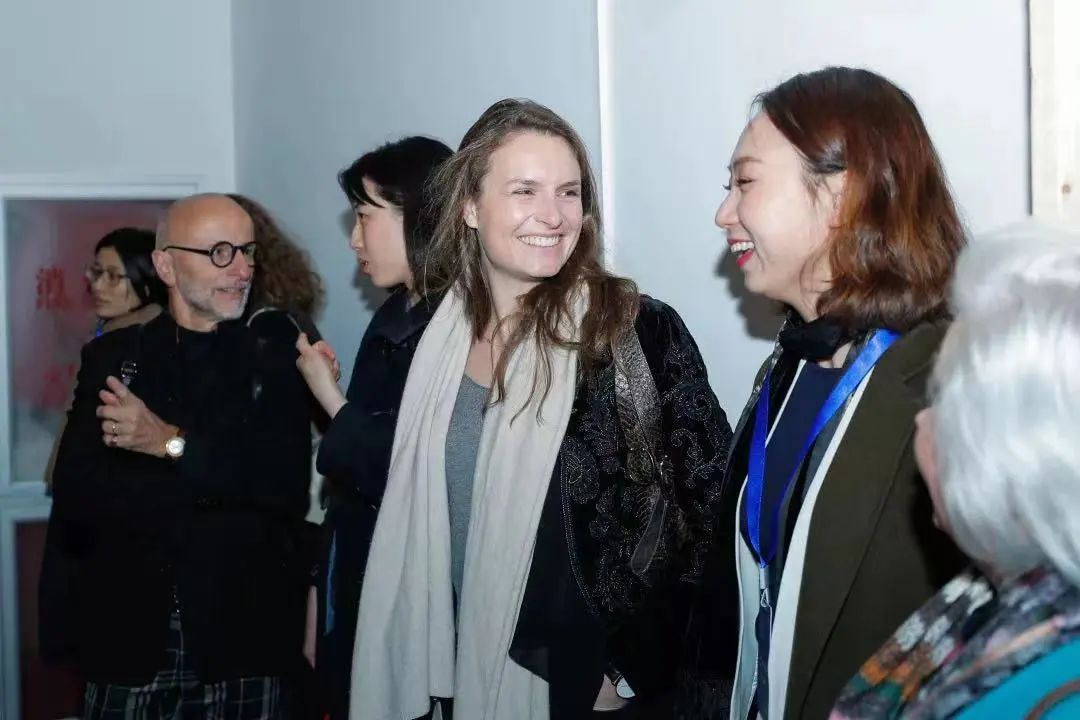

VIP Day Event-Visit by Zurich Collectors Group at Gallery Weekend Beijing in 2019, Courtesy GWBJ WeChat Account

The Up&Coming Sector at Gallery Weekend Beijing in 2021, Courtesy GWBJ WeChat Account
III.
Thomas Eller’s resignation and the development of the Gallery Weekend Beijing after that hint at key issues for its future development. The First Beijing Gallery Weekend chose to cooperate with a few galleries and provide them with the best possible service during the Gallery Weekend Beijing, attracting the attention of international collectors and art professionals, and at the same time showcasing Chinese contemporary art to the world. This approach was to rely on the high-quality service of Gallery Weekend Beijing, focus on the local area, and “bring in” the attention of the international community, so as to achieve the purpose of promoting Chinese contemporary art. After the Second Gallery Weekend Beijing established a solid foundation, the new team gradually stepped out of the Berlin model and opened up more international exchanges. The Third Gallery Weekend Beijing and Zurich Art Week reached a cooperation, and the two sides invited each other's galleries to debut on respective platforms; in the Fourth Gallery Weekend, the two platforms reached an exclusive cooperation, and the gallery leaders from the two places communicated on the international forum established by them... The updated Gallery Weekend Beijing team adopted the policies of “bringing in” and “going out” in a step-by-step approach, communicated with colleagues in the international art industry, and showed the world the scenes of contemporary Chinese art.

Wang Yifei, Director of Gallery Weekend Beijing

Exhibition View of Gallery Weekend Beijing in 2019
Focusing on the local ecology or actively expanding international exchanges and actively integrating into international contemporary art, the difficulties encountered by the Gallery Weekend Beijing since its founding have been clearly resolved in the Sixth Gallery Weekend Beijing. The theme was "Sharing" in 2022, with the Main Sector and Special Sectors, plus a special section launched by partners. In addition to the solo and group exhibitions of 22 galleries and 7 non-profit institutions, the Main Sector also introduced a special exhibition and the best exhibition award. The Special Sectors continued to offer targeted exhibitions and a series of activities in three sectors: Visiting Sector, the Up&Coming Sector, and the Public Sector. Enlisting the participation of more than 20 artists represented by Main Sector galleries, the special exhibition showcased a strong mix of artworks, including video, installations, sculptures, and paintings, among other mediums. Crosstalk was co-curated by four young curators from Beijing Inside-Out Art Museum and UCCA Center for Contemporary Art – Wenlong Huang, Neil Zhang, Yichuan Zhang and Jiashu Zou.
 GWBJ 2022 Main Sector Special Exhibition Crosstalk
GWBJ 2022 Main Sector Special Exhibition Crosstalk

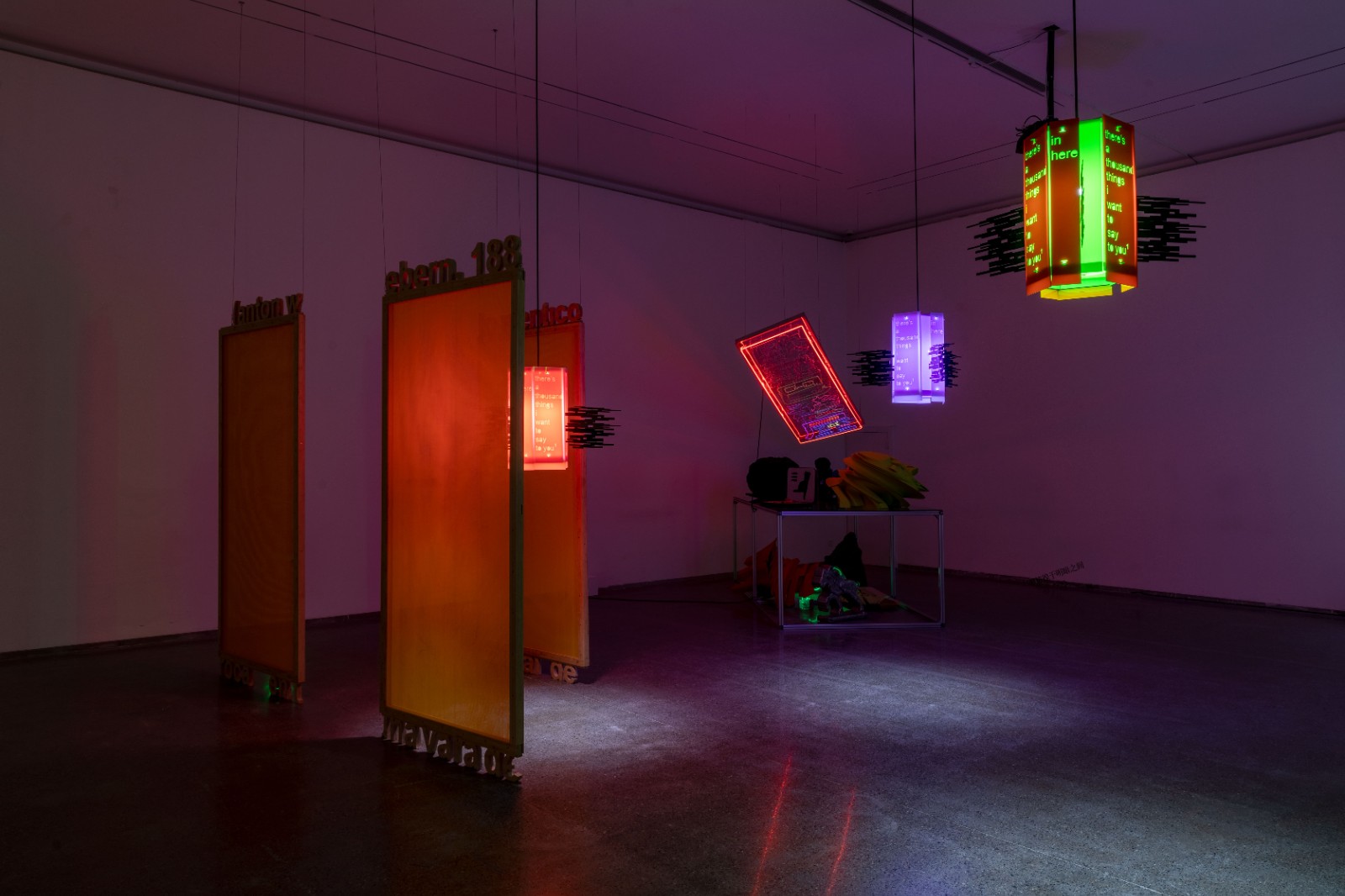
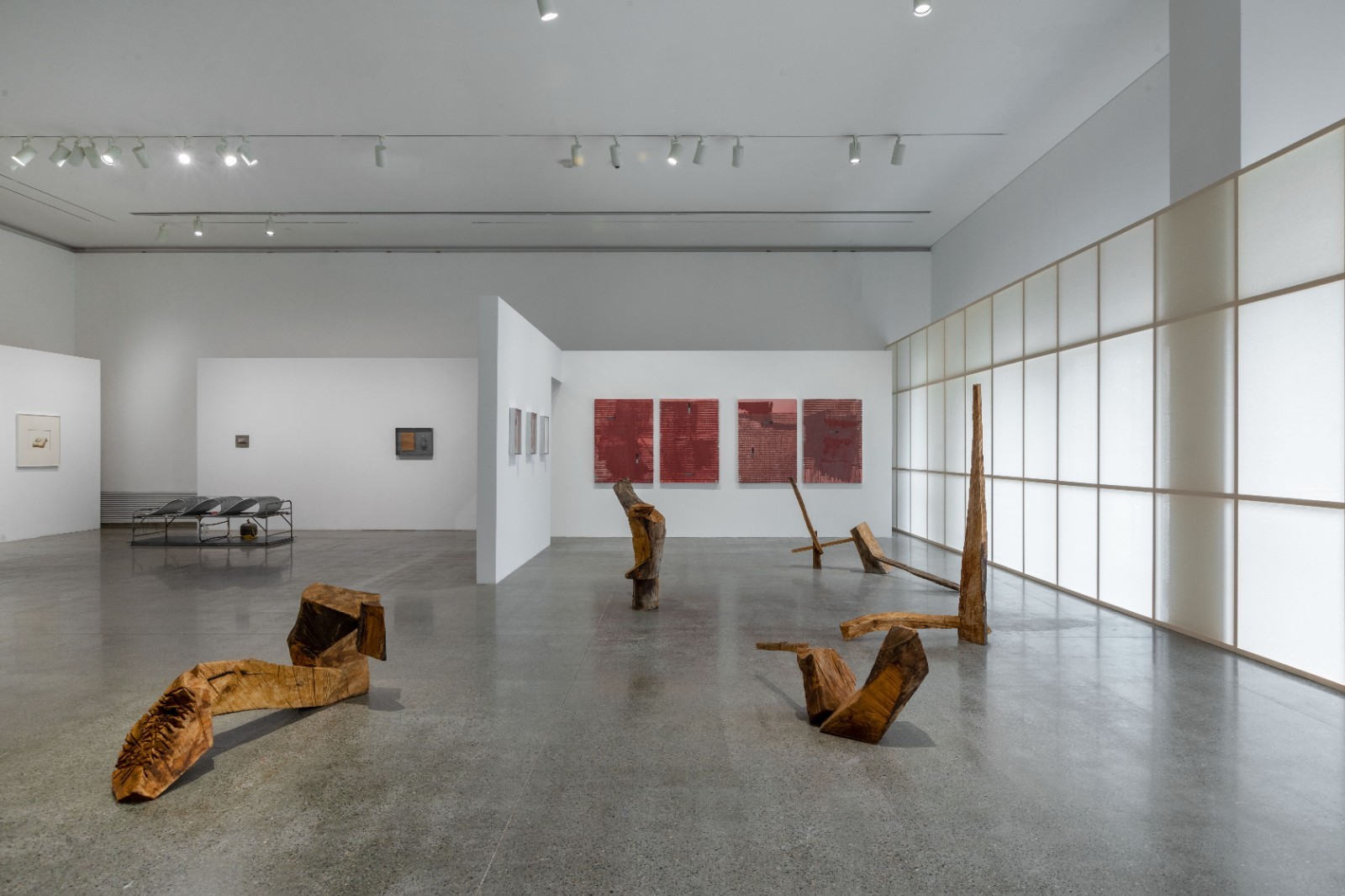
 Exhibition View of GWBJ 2022 Main Sector Special Exhibition Crosstalk
Exhibition View of GWBJ 2022 Main Sector Special Exhibition Crosstalk
The exhibition’s title, Crosstalk, draws inspiration from the imagery of Recitativo, a reference to a rhythmically free vocal style that imitates the natural inflections of speech, which is used for dialogue and narrative in operas and oratorios to advance the plot as an “introduction”. Through revisiting and re-reading the artists’ works, the curatorial team examine the existence of the artists’ experiences in time, space, and text and present them in two narrative blocks in the exhibition: “Close Viewing” and “Towards Darkness”. These two seemingly separate chapters echo and interlace with each other in a continuous narrative flow and constantly initiate new dialogues. [4]
The 2022 Main Sector galleries also featured a selection of dual and group exhibitions that explore the relationship between artists across various disciplines: recipient of the first Sigg Fellowship for Chinese Art Research in 2020, Yang Zi curated A Place for Concealment (2022) at Galerie Urs Meile, an exhibition that strives to explore the question of how psychologically perceived space is presented on the two-dimensional plane. Hive Center for Contemporary Art hosted two solo exhibitions by Gong Chenyu and Kaito Itsuki, the latter of whom is the only Japanese artist presented at this year’s GWBJ. Demonstrating the strength of female artists, Tabula Rasa Gallery hosted a group exhibition comprising Lydia Blakeley, Nell Brookfield, Clémentine Bruno, Kristy M Chan, Yulia Iosilzon, Alicia Reyes McNamara, Amy Steel and Sofia Stevi. To commemorate the 20th anniversary of the founding of TOKYO GALLERY + BTAP’s Beijing outpost, Feng Boyi curated a show entitled Overlaid: Tokyo Gallery +BTAP (Beijing) 20th Anniversary Special Exhibition.
 The Up&Coming Sector Forum, Art, as labour, (re)production and gift-giving: the possibility of artistic collaboration
The Up&Coming Sector Forum, Art, as labour, (re)production and gift-giving: the possibility of artistic collaboration
Poster of A Special Project by GWBJ Public Sector 2022 × GE YULU The Collective Express
In the “Special Sector”, the Up&Coming Sector cooperated with the Huayu Annual Award, and invited young artists and scholars to discuss the possibility of cooperation in the form of a forum. Dedicated to galleries with spaces outside Beijing, the 2022 Visiting Sector saw galleries with spaces in major global art hubs host exhibitions within the 798 Art Zone. Homegrown participants from the Greater China region include BANK/MABSOCIETY (Shanghai)’s exhibition captured the fascinating dialogue between Jin Shan's sculptures and Tianzhuo Chen's video works; Kiang Malingue (Hong Kong, Shanghai), formerly known as Edouard Malingue Gallery, returned with Chou Yu-Cheng’s Sedimentary Gradient, a showcase of ten paintings created in the last two years.
A Special Project by GWBJ Public Sector 2022×GE YULU The Collective Express, carries 8 artists’ artworks in different media, run on the track laid from the 798 Art Center as the starting point, and explored a new way of accommodating art in public space. The specially launched digital art sector has brought six pioneering artists to look at emerging fields such as the metaverse and digital art, which is also the focus of current public attention, reflecting the tracking and thinking of the Gallery Weekend Beijing team on the development of art in the post-pandemic era.
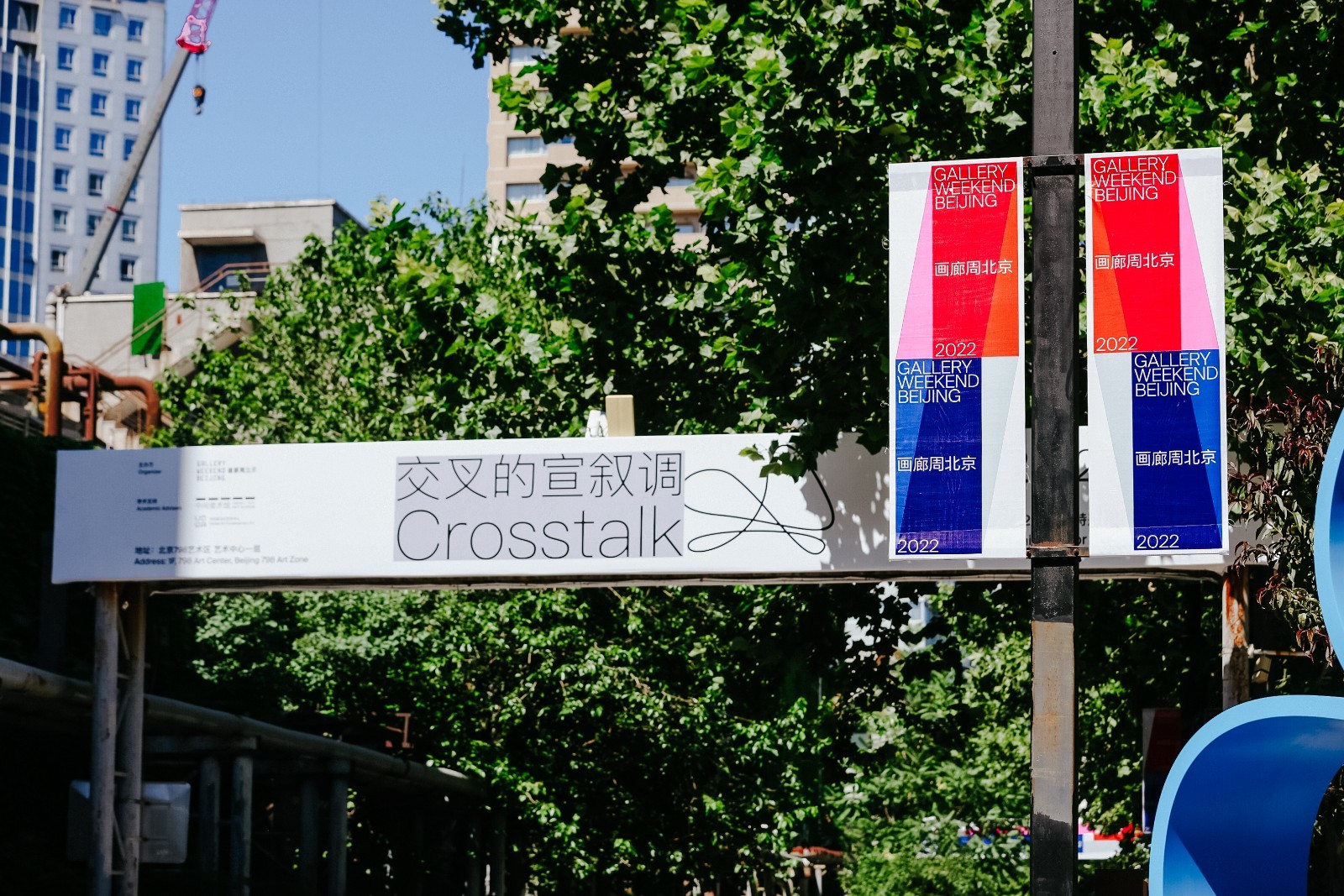

Exhibition View of Gallery Weekend Beijing 2022 in 798 Art District
“Our Choice to cooperate with a few galleries and provide the best service possible. This also reserves space for future development.”[5] The approach of the First Beiing Gallery Weekend is to find a stable and continuous approach in a rapidly changing era. The Gallery Weekend Beijing organized by the new team adapts to the epochal development and the trend in globalization. While based on the local art ecology, it actively embraces changes and promotes international exchanges. It is committed to building Gallery Weekend Beijing into an international contemporary platform for art dialogue and promotion, highlighting the innovation and vitality of Beijing. Doesn’t the Gallery Weekend Beijing take its own course with this approach?
Text by Yang Zhonghui, edited and translated by Sue/CAFA ART INFO
References:
[1][2][5] “Ran Dian | Interview with Thomas Eller, Founder of Beijing Gallery Weekend”, quoted from https://www.randian-online.com/np_market/interview-with-thomas-eller-founder-of-beijing-gallery-weekend/ ;
[3] “2012 Gallery Weekend Beijing Opens, Six Art Districts Perform Carnival”, quoted from https://www.chinanews.com.cn/cul/2012/09-24/4207541.shtml
[4] Press Release for the Sixth Gallery Weekend Beijing in 2022.


